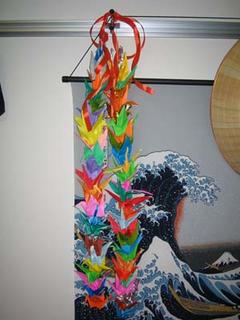...pation?
Well, here's the low down. I have seen how the other half lives (that is to say in giant palaces of houses.) Today I saw how the other half works. That's right, I got to help out at an elementary school!
A group of JLSP students met at Ichigaya station at 9:20 this morning and were met by two of the JLSP coordinators. There were maybe 15 students total. We rode 3 trains and a bus (about an hour's trip) to get to the school.
As soon as we walked in the door, the oohs and aahs started. As is customary, we traded out outside shoes for the in-school slippers. My slippers fit perfectly... on the first half of my foot. I've had more comfortable "church shoes". We had a small group of student on-lookers and several murmurs of "Wow, what big foreigners."
Next we were escorted into a meeting room where we had coffee and tea and were introduced to the vice principal. The vice principal gave an overview of the schedule for the day. A bit later, the principal came in and gave a brief introduction. We sat around in the meeting room for a bit before an assistant came in and told us "the gym was ready."
We shuffled into the gym which was packed with children. All of the children and teachers were there, it was very intimidating. There was a roar of "Woah!" as we entered. There was a row of chairs set up in the front of the gym for us. the principal said a few words before we each gave a quick self-introduction. Mine went something like "Hello, I'm Mike from America. Nice to meet you." Next the students sang us the school anthem. The young students sang louder and the older students sang more in key. Finally, everyone (us included) sang "Head, Shoulders, Knees, and Toes"
After the "assembly" ended, two very small girls came up to me and stood next to me. They looked as if they wanted to ask me a question. I asked what they wanted and they pulled on me to get me to stand. Evidently they were the envoys from the class, sent to get me. I was taken over to there my class (2-3: second grade class 3) where I was greeted by another round of oohs and aahs. I greeted everyone and said hello to the teacher. We then left the gym and went to the classroom.
The teacher and I made small talk on the way and the kids followed along in awe. The two "envoys" were still holding my hands and did so until we got in the classroom. The classroom looked like, more or less, any elementary classroom on the planet. The desks were arranged in a circle. My desk was larger than all the rest and had a sign on it that said "Ma-i-ku sa-n". Everyone took their seats and class began.
On the front chalkboard was a beutyfully made sign noting what our class was going to do. Two students acted as MCs and announced who was doing what. First a student who has a Phillipino mother got up to give a speech in English, but was too shy, so he did it in Japanese. Next I was asked to give my self-introduction again.
Continuing on, the theme of the day was "what we do for fun". Various students showed off thier skills like "Cat's Cradle", Slip-rope (dangerous in the classroom), Judo, and Yo-yo-ing.
Once everyone had shown off thier abilities it was time for Q&A. There were a lot of good questions, asked in Japanese... and answered in Japanese (yay mad skillz.) Some questions I expected like, "How tall are you?" and "Where exactly are you from?" Some I didn't expect like, "What kind of bugs so you like?", "How big are your hands?" (19cm it turns out), and "How do you study Japanese in the states?" There was also a round of "What is ~~ in English?"
Next we played a rousing game of Japanese Duck-Duck-Goose. In the Japanese version everyone is silent. The outer person drops a hankerchief behind the runner. The rest is just like DDG. After the game was over and we returned to our desks I was presented with a wonderful set of origami cranes. The teacher explained what they ment but I didn't quite catch what. Below: the cranes hung up in my room.

Lunch was awesome! Some of the kids split off and put on uniforms and brought the school lunch into the classroom and put it on a cart in the front. All of the kids moved thier desks into groups of 4 and there was an EPIC game of "Rock-Paper-Scissors" to see which group my desk would be put with. I was requested to stay seated and be served, which was fun. For lunch there was some sort of vegitable mix, a baked-chicken-burger, milk, and REALLY good roll (I find good bread hard to come by here.)
As lunch ended a student asked for my autograph. Seeing a classmate get one, everyone came over and had to get one. Eventually someone gave me thier name (in roman charecters) So everyone else did so too. Below: everyone's autograph on origami paper.

There was a massive "Sayonara - bye bye" as I was lead by the two envoys back to the meeting room. On the way we were stopped by several students from various other classes who wanted my autograph too.
Back in the meeting room, after everyone arrived, we gave feedback to the principal and vice principal. We were also asked to provide E and snail mail addresses so the students can keep in contact. Then we departed for the train station and home.
"Lean On Me" (A good Morgan Freeman fix) is on the tele in English with subtitles (A good English language fix). Tomorrow's plan is to visit Odaiba, a man made island in Tokyo bay. It's more or less the Tokyo equivalent of Mt. Trash-more. There's a famous convention center there, as well as a giant ferrisweel, and a nice view of the Rainbow Bridge (another Tokyo landmark). Sunday I plan on hitting up the Tokyo Motor Show if I can find where it is being held. Hmmm, turned out to be a long post, oh well, movie time.
Ja Mata Ne.







